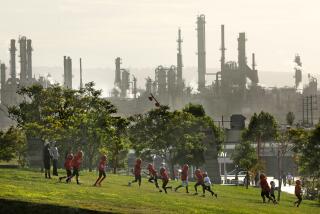‘Toxic tour’ is trash talk and real dirt
- Share via
You won’t find any homes of the stars on this tour bus as it shuttles rubber-necking sightseers through Los Angeles.
You may not even see the Hollywood sign through the haze from the smokestacks, rail yards and refineries along this “toxic tour” through neighborhoods southeast of Los Angeles.
“To your left is a brownfield,” guide Roberto Cabrales announces from the front of the bus to two dozen tourists aboard. “To your right, that’s a former steel company. It’s contaminated with heavy metals.”
The half-day excursions by the advocacy group Communities for a Better Environment were begun in 1994 as a way to show a handful of government officials the consequences of their decisions in low-income and predominantly Latino communities.
Increased demand for the tour from universities, school groups and families now has the Huntington Park-based organization hosting hundreds of visitors on dozens of bus trips a year. Admission is free, but donations are sought to pay for the bus rental.
Lately, curious residents have also been climbing aboard.
Luis Reyes, a 19-year-old college student from Inglewood, brought his two younger brothers and sister, ages 15, 11 and 13. “I want them to understand the effects of how we live and where we live,” he said.
Los Angeles is not alone in offering these kinds of excursions. Environment-themed reality tours exist across the country, including in the San Joaquin Valley.
The L.A. tour starts with the shuttered factories and weed-covered lots of Huntington Park and South Gate, once a manufacturing hub.
“Under your seats there is a gas mask,” jokes Cabrales, a community organizer in plastic-rimmed glasses and a goatee who peppers his narrative with historical references, health statistics and jocular asides.
At Raul R. Perez Memorial Park, he shows off a playground that sits where a five-story pile of freeway rubble from the 1994 Northridge earthquake loomed for years, sending noxious dust into a neighborhood that named the mound La Montana: The Mountain. It took years for it to be removed.
At another stop, sightseers step off the bus to watch trains rumble through the Alameda Corridor, a below-ground trench through which shipping containers from the nation’s largest port complex in San Pedro and Long Beach head for a massive rail yard near the 710 and 60 freeways in Commerce.
Next they see the metal recyclers and scrap yards, where old cars and bed frames tower high above homes that for years have complained about the smell and noise.
As the bus crosses into Maywood, next to the almost exclusively industrial city of Vernon, Cabrales says, “Here you can see the residences and just how close they are to industry.”
When the bus pulls up at a rendering plant in Vernon, riders give a collective gasp. They pinch their noses and cover their mouths as a view over the fence of Baker Commodities reveals a pile of dead dogs, a horse carcass and animal byproducts awaiting processing.
Next is the Exide Technologies battery recycling plant in Vernon, where a white plume spews into the air and Cabrales tells everyone to stay in the bus. State officials temporarily closed the plant in April after environmental regulators found its arsenic emissions posed a health risk to as many as 110,000 people in surrounding communities. A judge allowed the plant to reopen earlier this month.
The bus cruises down the 710 Freeway, where tens of thousands of trucks travel in and out of the port complex every day, putting adjacent communities at higher risk of asthma and cancer. The sightseers snap photos of the shipping containers and cranes as the driver heads toward Wilmington, an L.A. neighborhood surrounded by several oil refineries and the Port of Los Angeles.
The group gets out of the bus on a dead-end street where rows of tidy houses sit just beyond the fence of the ConocoPhillips oil refinery. They see the white plumes and, above the sound of machinery, hear about the nighttime flaring that bathes the neighborhood in an eerie orange glow.
For lunch, the tourists stop to reflect at Wilmington Waterfront Park. The 29 acres of trees, lawns and hills opened in 2011 as a buffer zone between homes and the port. Still, signs warn visitors of methane gas intrusion from the soil below.
“It really hits close to home,” said Karen Diaz, a Cal State Long Beach student who grew up in Downey.
“Had I ever gone to Wilmington and seen the smokestacks? No. You see these things, but you drive past them.”
--
More to Read
Sign up for The Wild
We’ll help you find the best places to hike, bike and run, as well as the perfect silent spots for meditation and yoga.
You may occasionally receive promotional content from the Los Angeles Times.







